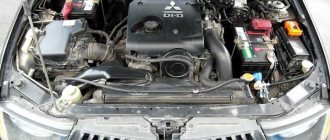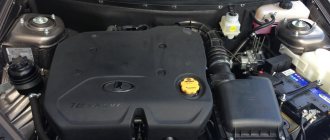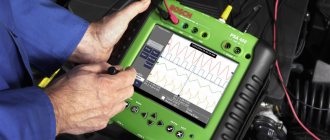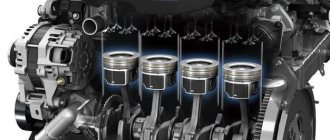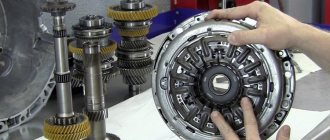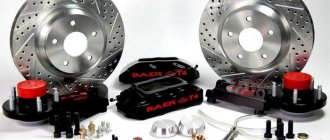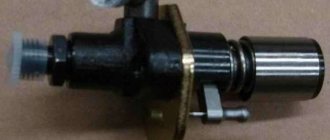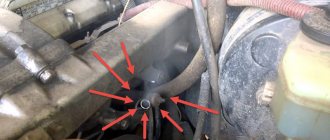Conventional wisdom holds that diesel engines produce a lot of noise, smell bad, and don't produce the required power. They are considered to be suitable only for trucks, vans and taxis. Possibly in the 1980s. everything was like that, but since then the situation has changed radically. Diesel engines and fuel injection controls have become much more sophisticated. In 1985 Almost 65,000 diesel cars were sold in the UK (approximately 3.5% of total cars sold). For comparison, in 1985 Only 5380 were sold (data probably for the US market).
The main parts of a diesel engine must be stronger than those of a gasoline engine.
Ignition. Sparks are not required for ignition, because the mixture ignites under compression.
Glow plugs. Heats up the combustion chamber during a cold start.
Many diesel engines are based on gasoline engines, but their main parts are more durable and can withstand high pressures.
Fuel enters the engine via a metering injection pump, which is usually attached to the side of the cylinder block. The system does not use electric ignition.
The main advantage of diesel engines over gasoline engines is reduced operating costs. Diesel engines are more efficient due to strong compression and lower fuel costs. Of course, diesel prices can vary, so a diesel car will cost you a lot if you live in an area with high diesel prices. In addition, such cars require maintenance less often, but oil changes are organized for them more often than for cars that run on gasoline.
How do diesel engines work?
Inlet
As the piston moves down the cylinder, the intake valve opens, admitting air.
Compression
When the piston reaches the bottom of the cylinder, the intake valve closes. The piston rises, compressing the air.
Ignition
Fuel is injected into the cylinder when the piston reaches the top base. This ignites the fuel and sets the piston in motion again.
Release
On the way back, the piston opens the exhaust valve and the exhaust gas exits the cylinder.
Four-stroke diesel and gasoline engines operate differently, even though they contain the same components. The main difference lies in the way the fuel is ignited and the resulting energy is managed.
In a gasoline engine, the mixture of air and fuel is ignited by a spark. In a diesel engine, the fuel is ignited by compressed air. In diesel engines, air is compressed on average at a ratio of 1/20, while for gasoline engines this ratio is on average 1/9. This compression greatly heats the air to a temperature sufficient to instantly ignite the fuel, so there is no need for sparks or other ignition methods when using a diesel engine.
Gasoline engines absorb a lot of air per piston stroke (the exact volume depends on the degree of opening of the throttle opening). Diesel engines always absorb the same volume, which depends on the speed, and the air duct is not equipped with a throttle. It is closed by one intake valve, and the engine does not have a carburetor or butterfly valve.
When the piston reaches the bottom of the cylinder, the intake valve opens. Under the influence of energy from the other pistons and momentum from the flywheel, the piston is sent to the upper base of the cylinder, compressing the air approximately twenty times.
Once the piston reaches the top base, a carefully measured volume of diesel fuel is injected into the combustion chamber. The heated air during compression instantly ignites the fuel, which expands during combustion and again sends the piston down, turning the crankshaft.
As the piston moves up the cylinder on the exhaust stroke, the exhaust valve opens, allowing the spent and expanded gases to exit into the exhaust pipe. At the end of the exhaust stroke, the cylinder is again ready for a new portion of fresh air.
History of creation and improvement
The first scientific developments regarding the possibility of using fuel compressed to high pressure to ignite fuel in a heat engine were carried out in the 20-30s of the 19th century. In practice, this principle was implemented by the outstanding German inventor and engineer Rudolf Diesel, who in 1892 filed a patent for the invention of an engine of an original design, called a diesel engine in honor of its creator. After 3 years, the document was recognized by the United States. Over the course of several years, Diesel registered several more patents for various modifications of the diesel engine.
The first working unit was manufactured at the end of 1896, and its tests took place almost immediately - on January 28 of the following year. The first diesel engines used vegetable oils and light petroleum products as fuel. The power plant almost immediately began to show high efficiency, while also being very convenient to use. But in the first years after their invention, diesel engines were used mainly in heavy steam engines.
Two key improvements have made it possible to significantly expand the scope of practical use of diesel units. The first was the use of kerosene as a fuel, which was first used in 1898 by another great engineer of that time, the Russian-born Swede Rudolf Nobel. The second major rationalization decision was the invention of a high-pressure fuel pump (HPFP), which replaced the compressor previously used to compress fuel.
Robert Bosch made a serious contribution to improvements in fuel injection pumps in the 20s of the 20th century. He invented and introduced a model of a built-in pump and a compressorless nozzle, the use of which led to a significant reduction in the dimensions of the diesel engine, which, in turn, made it possible to install it first on public and freight transport, and in the second half of the 30s - for the first time to use it on passenger cars cars. Further improvements to the unit in question, in particular the use of special diesel fuel, allowed the power plant using this type of fuel to successfully compete with gasoline engines, constantly increasing its market share.
Diesel engine design
Diesel and gasoline engines are made up of the same parts that perform the same functions. However, diesel engine parts are more durable because... they are designed to withstand heavy loads.
The walls of a diesel engine block are usually much thicker than the walls of a gasoline engine block. They are reinforced with additional bars that block impulses. In addition, the diesel engine block effectively absorbs noise.
Pistons, connecting rods, shafts and bearing housing caps are made from the most durable materials. The cylinder head of a diesel engine has a special appearance associated with the shape of the injectors, as well as the shape of the combustion chamber and swirl chamber.
Additional engine components
There are other parts in the design of a diesel engine. For example, a turbine. Many engines are equipped with turbocharging to increase power. Ordinary atmospheric engines do not have such a device.
Let's look at what turbocharging is and what it consists of.
Turbine operating principle
A large amount of air is supplied to the cylinders through turbocharging. The fuel supply during the operating cycle also increases. All this allows you to increase engine power.
Since the pump pressure in a diesel engine is higher and constant, this helps to avoid turbochargers, which are often present in a gasoline engine. Which owners of gasoline turbo engines are also often dissatisfied with.
The operating principle of the turbine is as follows:
- The exhaust gases pass through the compressor.
- They gradually spin the turbine wheel.
- Then the rotation of the turbine wheel is transferred to the compressor wheel. This is because they are both mounted on the same shaft.
- Under the influence of rotation, the turbocharger compresses the air. Then the latter enters the intercooler.
- Here it begins to cool. Then it goes back into the cylinders of the power unit.
This is how the turbine device works. The diesel engine starts even at subzero ambient temperatures. Glow plugs heat the air mixture to 900 degrees. That is why cold air masses can enter the cylinders through the turbines.
Turbocharging, also known as a turbocharger, consists of
Turbocharging of diesel engines consists of the following components:
- air intake;
- compressor;
- valve for regulating exhaust gases;
- throttle valve;
- filter device;
- intercooler for cooling air masses;
- pressure sensors;
- intake manifold;
- connecting tubes.
In turn, the turbine includes the following elements:
- bearings that create its rotation;
- turbine cover;
- compressor cover;
- steel mesh.
There are different types of turbochargers and their features. For example, in a variable geometry turbine, a modified cross-section of the inlet valve regulates the flow of exhaust gases. Two compressors are installed in series so that one device is responsible for each operating mode, and not two for all or one for all operating modes.
If the compressors in the engine are installed in parallel, then the turbo lags become barely noticeable. Mechanical and automatic turbocharging, installed together, contribute to increased power. For example, the first one turns on at low speeds, and the second one at high speeds.
Turbocharging cycle
Now you know what turbocharging is and how it works. Let's see what his cycle is.
- The turbocharger creates a vacuum. Air masses are sucked inside the turbocharger.
- Then the rotors come into operation.
- The intercooler cools the air masses.
- The intake manifold allows cold air to flow through it. But before it gets into it, the air masses are cleaned through air filtering devices.
- When enough air has been drawn in, the valve will close.
- The already exhausted air masses pass into the turbine of the internal combustion power unit and put pressure on the rotor.
- The rotation speed of the turbine itself and its shaft increases to 1500 rpm.
Thus, due to all these actions, pressure is generated, which increases the power of the diesel engine.
Similar article Installing a diesel engine on a Niva without modifications
Intercooler and injector
The intercooler for a diesel engine was created so as not to subject engine parts to daily repairs. When exposed to high temperatures, engine parts are subject to rapid wear. To prevent this from happening, intercoolers were created.
The fuel supplied through the injectors is distributed correctly and in the right quantity. Therefore, detonation does not occur when the feed angle is correctly positioned.
Injection
For any internal combustion engine to operate smoothly and efficiently, the correct mixture of air and fuel is required. For diesel engines, this problem is especially relevant, because air and fuel are supplied at different times, mixing inside the cylinders.
Fuel injection into the engine can be direct or indirect. According to established tradition, indirect injection is more often used, because it allows you to create vortex flows that mix fuel and compressed air in the combustion chamber.
Direct injection
With direct injection, the fuel falls directly into the combustion chamber located in the piston head. This shape of the chamber does not allow mixing air with fuel and igniting the resulting mixture without the harsh knocking characteristic of diesel engines.
An indirect injection engine usually has a small spiral swirl chamber (prechamber). Before entering the combustion chamber, the fuel passes through a swirl chamber, and vortex flows are formed in it, ensuring better mixing with air.
The disadvantage of this approach is that the swirl chamber becomes part of the combustion chamber, which means that the entire structure takes on an irregular shape, causing combustion problems and negatively affecting engine efficiency.
Indirect injection
With indirect injection, fuel enters a small pre-chamber and from there into the combustion chamber. As a result, the structure takes on an irregular shape.
A direct injection engine is not equipped with a swirl chamber, and the fuel enters directly into the combustion chamber. When designing combustion chambers in the piston crown, engineers must pay special attention to their shape to ensure sufficient vortex strength.
Features of operation and maintenance
In order for the unit to work for a long time and without interruptions, it is necessary to ensure its proper maintenance and operation. This is especially true for its fuel system.
- Google+
- LJ
- Blogger
Oil requirements
Diesel places high demands on oil quality. High-power diesel engines require the use of lubricant class B2 and higher. In addition, the replacement interval must be strictly adhered to.
According to European standards, the oil is changed after 10 thousand kilometers - twice as often as with gasoline engines.
- Google+
- LJ
- Blogger
Glow plugs
To warm up the cylinder head and cylinder block before a cold start, diesel engines use glow plugs. Short and wide spark plugs are an integral part of the car's electrical system. When the power is turned on, the elements in the candles heat up very quickly.
The spark plugs are turned on by turning the steering column specifically or using a separate switch. In the latest models, the spark plugs turn off automatically as soon as the engine warms up and accelerates above idle speed.
Speed control
Unlike gasoline engines, diesel engines have no throttle, so the amount of air they consume remains the same. The engine speed is determined only by the volume of fuel injected into the combustion chamber. The more fuel, the more energy is released during combustion.
The gas pedal is connected to a sensor in the ignition system, and not to the throttle, as in cars that run on gasoline.
To stop the diesel engine, you still need to turn the ignition key. In a gasoline engine, the spark disappears, and in a diesel engine, the solenoid responsible for supplying fuel to the pump is turned off. After this, the engine consumes the remaining fuel and stops. In fact, diesel engines stop faster than gasoline engines because the high pressure slows them down so much.
Fuel system design
The history of the creation of the diesel engine began in the 19th century. It was then that engineer Rudolf Diesel created a compression ignition unit. The first diesel engine ran on regular kerosene.
- Google+
- LJ
- Blogger
Scientists have used different types of fuel to get better results. The engine ran on palm and rapeseed oil, crude oil, and later they began to use fuel oil and diesel fuel.
WATCH THE VIDEO
However, the injection system was imperfect, which did not allow the use of a diesel internal combustion engine in cars that operated at high speeds. The power of the first diesel engine was not very high, but gradually the problem was solved.
- Google+
- LJ
- Blogger
The first diesel cars appeared only in the 20s. XX century These were trucks and public transport. Another 15 years later the first passenger cars appeared, but they were not widespread. The history of the diesel engine began to change only in the 70s. It was at this time that the compact internal combustion engine appeared.
- Google+
- LJ
- Blogger
How to start a diesel engine
Diesel engines, like gasoline engines, start when an electric motor is turned on, which starts the compression and ignition cycle. However, at low temperatures, diesel engines have difficulty starting because the compressed air does not reach the temperature required to ignite the fuel.
To solve this problem, manufacturers make glow plugs. Glow plugs are battery-powered electric heaters that turn on a few seconds before the engine starts.
Injectors and intercooler
The operating principle of the intercooler, as well as the injectors, and indeed their purpose, are, of course, radically different. The first, by heat exchange, reduces the temperature of the air, which, when hot, greatly affects the durability of the engine. The injector is responsible for dosing and atomizing the fuel.
It operates in pulse mode due to a cam extending from the camshaft and the nozzles themselves.
Diesel fuel
The fuel used in diesel engines is very different from gasoline. It does not undergo purification, and therefore is a viscous, heavy liquid that evaporates rather slowly. Due to these physical properties, diesel fuel is sometimes called diesel oil or fuel oil. In service centers and gas stations, cars running on diesel fuel are often called dervs (from diesel-engined road vehicles).
In cold weather, diesel fuel quickly thickens or even freezes. In addition, it contains a small amount of water, which can also freeze. All types of fuel absorb water from the atmosphere. Moreover, it often penetrates into underground reservoirs. The permissible water content in diesel fuel is 0.00005-0.00006%, i.e. a quarter glass of water per 40 liters of fuel.
Ice or water build-up can block fuel lines and injectors, preventing the engine from running. This is why in cold weather you can see drivers trying to heat the fuel line with a soldering iron.
As a preventative measure, you can carry an additional tank with you, but modern manufacturers already add impurities to the fuel that allow it to be used at temperatures above -12-15°C.
Malfunctions and diagnostics of injection pump
The fuel pump can be called the “heart” of the unit. Thanks to it, fuel flows into the chambers. The main malfunctions are associated with poor fuel quality, as well as the use of old oil.
Dark smoke from the exhaust pipe
This indicates that there is poor mixture formation in the cylinders, which is associated with late injection. Additionally, injectors and valve clearances should be inspected.
- Google+
- LJ
- Blogger
